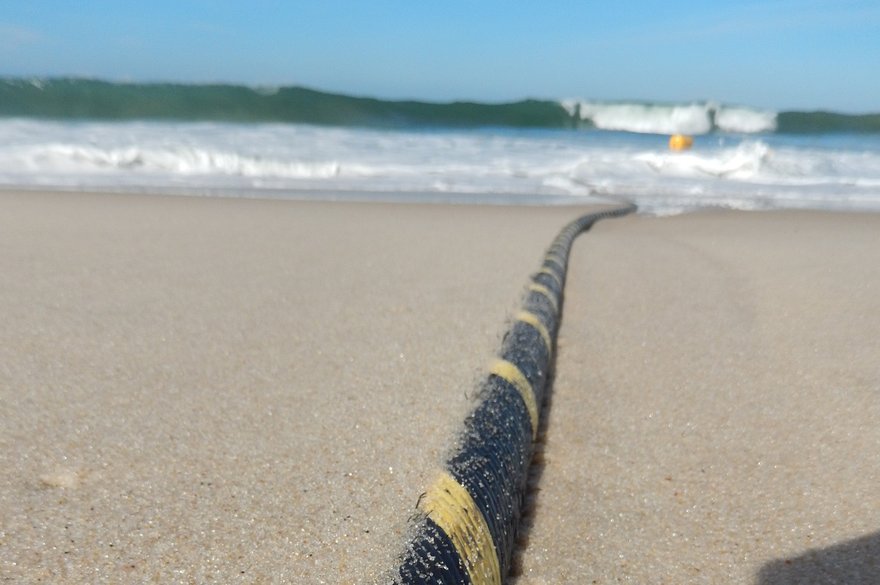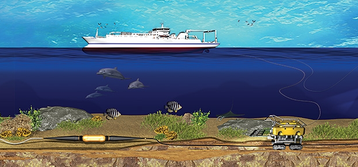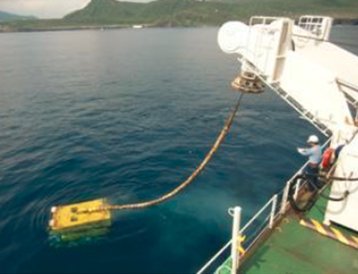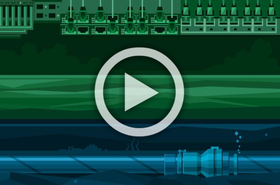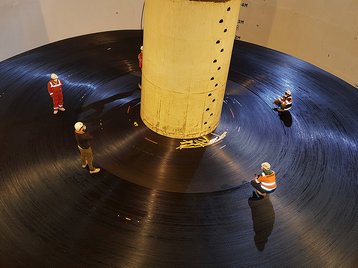Though we live in an increasingly wireless world, that connectivity depends on wires under the ocean.
Subsea or submarine cables are fiber optic cables that connect countries across the world via cables laid on the ocean floor. These cables – often thousands of miles in length – are able to transmit huge amounts of data rapidly from one point to another.
What is a submarine cable?
A submarine cable is a fiber optic cable laid in the ocean, connecting two or more landing points.
Rarely much wider than a garden hose, today cables generally comprise of the optical fibers that carry the information, which are then covered in silicon gel, then sheathed in varying layers of plastic, steel wiring, copper, and nylon in order to provide insulation to protect the signal and protect the cable from damage from wildlife, anchors & fishing, or weather & other natural events.
The cables are laid using ships that are modified specifically for this purpose, transporting and slowly laying the ‘wet plant’ infrastructure on the seabed. These special ships can carry thousands of kilometers of optical cable out to sea. A special subsea plow is also used to trough and bury submarine cables along the seabed closer to shorelines where naval activities, such as anchoring and fishing, are most prevalent and could damage submarine cables.
“We've had submarine cables for over 150 years,” explains Gil Santaliz, founder and CEO of New Jersey cable landing station NJFX, “and they've really been a way for communication between countries and continents.”
“The most basic application is communicating what's happening in one part of the world to another, but we've morphed that to allow applications to exist in multiple countries at the same time, to enhance the performance of applications, and to find eco-friendly locations where you can run applications with a zero-carbon footprint yet enjoy the application the country where they don't have that resource.”
Subea cables; connecting the world for 170 years
Work to demonstrate the potential of subsea cables began in the 1840s, when Samuel Morse, the inventor of Morse Code, submerged a wire insulated with tarred hemp and India rubber, in the water of New York Harbor and telegraphed through it in 1842.
The first commercial cable was laid in 1850, when the English Channel Submarine Telegraph Company laid a telegraph cable between England and France. It was cut weeks later by fishermen thinking it was seaweed. A successor company, the Submarine Telegraph Company, laid a second cable the next year and more cables linking the British Isles to mainland Europe followed.
In 1854 and completed in 1858, the Transatlantic telegraph cable – which ran from Valentia in western Ireland to Bay of Bulls, Trinity Bay, Newfoundland and was the first to traverse the Atlantic – was laid by the Atlantic Telegraph Company. It only functioned for only three weeks before breaking beyond repair.
The first official telegram to pass between two continents – at a rate of a single character every two minutes – was a letter of congratulations from Queen Victoria of the United Kingdom to President of the United States James Buchanan on August 16. Following progressive signal deterioration, the cable was destroyed after excessive voltage was applied to try and boost the transmission strength. While it was only in operation for a short time, it showed intercontinental communication was possible and a second cable was laid in 1865.
The first trans-Pacific cables were completed in 1902 and 1903, linking the US mainland to Hawaii in 1902 and Guam to the Philippines in 1903.
The first subsea telephone cable, TAT-1, was laid between 1955 and 1956. A joint project between the UK Post Office (of which BT was part for a number of years), the American Telephone and Telegraph company (now AT&T), and the Canadian Overseas Telecommunications Corporation, it was able to carry 35 simultaneous telephone calls.
The eighth transatlantic communications cable, TAT-8, was the first fiber optic subsea cable. Constructed in 1988 by a consortium of companies led by AT&T, France Télécom, and British Telecom, the cable was able to carry 280 Mbits per second. It was retired in 2002.
Today there are more than 400 subsea cables in operation. Some connecting nearby islands can be shorter than 50 miles long. Others, traversing the pacific, can reach more than 10,000 miles in length. Some connect singles points across a body of water, others have multiple landing points connecting multiple countries.
Antarctica is the only continent not yet reached by a submarine telecommunications cable, though one is reportedly being considered to improve connectivity for researchers in the region.
Cable technology evolves quickly
After choosing the desired route, specialist ships begin work of laying the cable, which is dropped to the ocean floor. These ships hold giant spools of cables before slowly and precisely unfurling and laying them on the ocean floor. As the cables begin to approach land, cables are often buried in trenches created by subsea plows in order to protect them from damage.
Though there were reportedly 16 instances of whale entanglement with submarine telegraphic cables were reported prior to 1966, today cables rarely interfere with local wildlife once laid, although they sometimes enable anemones and the like to fix into an area where they might not otherwise be able to settle.
Sharks have been known to occasionally bite subsea cables – possibly attracted by the electrical signals – most recently by Google in 2014. But such events are rare, and can be countered by additional cable armoring.
Last year more than 500,000 scallops were moved so that a fiber cable could be laid on the seabed off Port Erin and Port Grenaugh, on the Isle of Man in the British Isles. The 584-mile (940km) Havhingsten Telecommunication Cable will connect the island to Ireland, the UK, and Denmark.
Cables contain a number of repeaters, which boost the signal along the length of the cable roughly every 100km. At each end, the cables reach land within a cable landing station, from where the data is routed to its final location.
“Fiber optic cables leverage Dense Wavelength Division Multiplexing (DWDM), a technology whereby multiple wavelengths – each operating at rates of hundreds of gigabits per second – enable the information-carrying capacity of a submarine cable to be maximized,” explains Brian Lavallée, senior director of solutions marketing at telecoms and networking firm Ciena. “Optical amplifiers, which are still referred to as repeaters in the submarine networking space, amplify these signals over regular intervals as they traverse their transoceanic routes.”
In the same way the likes of OpenRAN and containers are creating more disaggregation between components, Lavallée says the introduction of Open Cables and disaggregation of SLTE from the ‘wet plant’ means cable systems can be more routinely upgraded and greater diversity of choice when selecting new components.
“The Open Cables model resulted in numerous new upgrade vendors joining the submarine networking industry, and submarine cable operators have understood and appreciated the benefit of a broader choice of SLTE technology and vendors. Submarine systems, such as Southern Cross, are now capable of more than 80 times their original design capacity with upgrades to SLTE technology.”
At each end of a cable is a cable landing station; much like a ‘normal’ data center, it houses important networking equipment which powers the cable and controls its operations.
“Traditionally, submarine line terminal equipment (SLTE) and power feed equipment (PFE) of a submarine cable system were installed at the cable landing station,” says Lavallée. “In some cases, the PFE is installed at a cable landing station, while the SLTE is installed in another location inland, such as a central office or, increasingly, a data center.”
Though capacity on existing cables is always increasing, Google’s Virginia-to-France Dunant cable is currently the largest capacity cable, capable of 250 terabits per second.
Santaliz says that while satellite Internet capacity is rising while costs are dropping, terrestrial and subsea systems are exploding.
“They're growing exponentially faster than even the satellite guys are and pushing more and more and more through those fibers than everyone ever thought possible,” he says. “A year and a half ago and an 8 pair system was a big deal, and prior to that four pair. Today they're doing 24 pair systems, and they're not just going A to B, they're going A to B to C to D to E
“I would say in the next four years you'll see petabit systems going across the Atlantic Ocean,” predicts Santaliz.
Following a trial earlier this year, the trans-Atlantic MAREA cable saw its potential capacity increase from 200Tbps to 224Tbps. The joint Microsoft-Facebook project was originally designed with a capacity of 160Tbps.
In July, TPG Telecom announced plans to upgrade its PPC-1 submarine cable between Sydney and Guam, boosting the data capacity of the cable by 50 percent using Infinera’s ICE6 800G product from 8 terabits per second currently to 12 terabits per second.
Japanese researchers recently achieved a new data transmission record, sending information at a rate of 319 terabits per second.
Cost vs resilience of subsea cables
Cables were traditionally owned by consortium telecoms firms who would band together to spread the costs of manufacturing and deploying a cable in exchange for being able to use some of the cable’s bandwidth. Today, cloud and hyperscale companies such as Facebook, Google, Microsoft, and Amazon are increasingly investing in subsea cables, both as part of traditional consortiums and as private projects.
Like any other digital infrastructure, cables can be bought and sold; Hawaiki Submarine Cable was acquired in July by an affiliate of shipping giant BW Group for a reported $445 million. And like any other digital infrastructure, a cable’s main risk is an unexpected outage.
Onland fiber outages are fairly common; cables and equipment can be eaten by rodents – has happened in Australia and New Zealand recently – or cut by construction works. Even cows treading on an above-ground fiber cable once caused intermittent outages.
While subsea cables might not face danger from cows or construction, risks to subsea cables do exist. Subsea cables have a greater tolerance for failure than terrestrial fiber, but issues that do arise can be costly, difficult, and slow to fix to the time and effort required to first reach and then lift cables to the surface.
“The characteristics are very different on the potential for an impact on a subsea cable to terrestrial cable,” explains Santaliz. “A terrestrial cable has 100 times greater chance of having something go wrong with it than the subsea cable, but yet the fix on a terrestrial cable can be days wherein a subsea environment it could be weeks.”
“You could have a problem with your subsea cable on one side – known as a shunt fault – but it's still operational and it would take another event to have that cable actually have an issue where it couldn't operate. You can tolerate one shunt fault, but then you're telling your ships to get ready to deal with this in a planned coordinated fashion.”
“But the cost is in the millions when you start dealing with a fixed or subsea cable, where terrestrials cables systems will be tens of thousands to go fix.”
There are, on average, around 100 cable faults a year. While animals and natural events are behind some incidents, the vast majority of cable damage is caused by fishing and shipping activity.
Fixing a damaged cable is incredibly time-consuming; once a fault is located, a ship must sail the area, find and lift the cable – both ends if completely cut – to the surface often via a rope and grapple or submersible robot. It can take more than a day to lift a cable from the ocean floor at deeper depths. Any damaged length of cable is removed and then the cable is spliced back together, sealed with adhesives and a joint, and lowered back to the ocean floor.
Earlier this year GTT Communications filed an injunction against local fishermen in Ireland to stop them trawling near to two of its submarine cables off the coast of Kilmore Quay in County Wexford.
In August, the Vocus Australia Singapore Cable was broken in 'multiple locations at challenging depths' off the coast of Perth, Australia. Though Vocus never officially declared the cause, the cable was rumored to have been broken by a ship’s anchor. The cable was repaired and declared operational 12 days later.
Cables can be broken by natural events too. In January 2020 two subsea cables off West Africa were damaged by undersea mudslides potentially caused by flooding in the Congo river.
“Natural causes account for only about 10 percent of faults,” says Ciena’s Lavallée, “but when they do occur, they tend to break cables in multiple places, which can cause problems in an entire region.”
“We saw that happen a few times, in 2006 and 2009 off the coast of Taiwan, and in 2011 off the coast of Japan [following earthquakes].”
Cable retirement & recycling
Santaliz explains that there are two ends of life of a cable; there's a physical end of life where it no longer functions and needs to be retired, and the economic end of life where it’s not worth the money to run a still functioning cable.
“You can have a cable that has been in the water 18 years, but because a new system gets done that's got very similar landings the economic life of the older system is not viable,” he explains. “They can't compete so for commercial reasons, so even though the cable still works they will probably turn it off prematurely because it's just not worth keeping it.”
The cost of maintaining at least two cable points, staff, and repair the cable as needed all represent fixed costs that make it harder to compete if a cable with more capacity follows similar routes and landing points to existing cables.
Once a cable is retired, however, there is often little effort made to recover it. While copper is valuable, it’s unlikely to recoup the cost of recovering a cable. And while many would argue leaving a cable to deteriorate in the ocean long-term is harmful, digging up a cable could also disturb any marine life in the area. Relocating cables is technically possible, but rarely happens.
Santazli expects, however, that in the future there could well be more mandates around recovering subsea cables on environmental grounds, at least within a country’s territorial waters.
“It's an economic question today, but the environmentalists are getting much more active demanding that we think this through. Some states in the US are going to demand that at least for our boundaries you don't leave that cable just sitting there rotting.”
In May, Subsea Environmental Services and Red Penguin Associates announced they had been selected to decommission the 20-year-old 15,428 km transatlantic TAT-14 telecommunications cable system. The planning phase of the project reportedly took almost a year, with in-shore work in US, UK, France, Denmark, and the Netherlands alone due to be complete by the end of 2021.
The politics of subsea cables
As cable technology has improved and costs have come down, remote countries that once would have to rely on satellite or slower infrastructure are rapidly seeing a massive increase in local cable capacity. In March it was announced the Galapagos Islands were to get a new subsea link to Ecuador offering bandwidth of up to 20 terabits per second (Tbps), increasing the Islands' current capacity by a factor of ten.
However, decisions around cable routes and participants are increasingly having to be made with concessions to potential political and regulatory fallout.
While the laying of terrestrial fiber can often be a political issue, it’s usually because people and businesses are demanding more of it from their local representatives. With subsea cables, however, their transnational nature means international relations can affect where a cable is laid and which companies are involved. Icy international relations, particularly between the US and China, means many proposed cables are being rethought or even canceled completely.
Earlier this year the East Micronesia subsea cable, due to connect the Pacific island nations of Nauru, Kiribati, and Federated States of Micronesia (FSM), was scrapped due to politics. It was reported that the World Bank-led project declined to award the contract rather than let it go to Chinese cable company HMN Technologies over national security fears. Nauru is negotiating with Australia to build a cable that would connect the island to the Coral Sea Cable system instead.
Earlier year a Hong Kong-to-US cable was canceled due to souring relations. The Facebook-led Hong Kong Americas (HKA) cable was first announced in 2018, with a consortium of Tata Communications, Telstra and the Chinese state-owned China Unicom and China Telecom Global Limited all involved. Facebook withdrew its FCC application amid “ongoing concerns from the US government” about direct communication links between the two countries.
Facebook, along with Amazon, previously withdrew an application for the Bay-to-Bay Express Cable System, which would have connected Singapore, Malaysia, Hong Kong, and the US, for similar reasons. Though as a potential substitute, the two companies are looking to develop the Philippines-California CAP-1 cable without previously-announced partner China Mobile to avoid issues with regulators.
The Pacific Light Cable Network (PLCN), a Google & Facebook project to link Los Angeles directly to China and Hong Kong, was scaled back for similar reasons as the B2BE system. Possibly as a replacement, the companies recently announced a US-Singapore cable project called Echo alongside the Japan-Singapore Apricot cable, both of which avoid China.
Existing cables are also potential political problems. In the UK the Ministry of Defence recently said the Royal Navy was to build a new surveillance ship to help protect the country’s Internet submarine cables. The Multi-Role Ocean Surveillance will include a bevy of sensors and a number of remotely-operated and autonomous undersea drones to search for foreign interference of submarine cables, including efforts to cut or tap the fiber.
The MoD claimed that Russia was “investing in and developing significant underwater capabilities, including deep-sea capabilities which can threaten undersea cables.”
The 9,800 km (6,000 mi) Oman Australia Cable (OAC), expected to be fully connected by the end of 2021, will connect Oman’s capital, Muscat, with Perth on the west coast of Australia. Sub.co said the cable’s route was planned to avoid possible extreme weather events and circumvent disputed territorial waters such as the Sunda Strait and the South China Sea.

